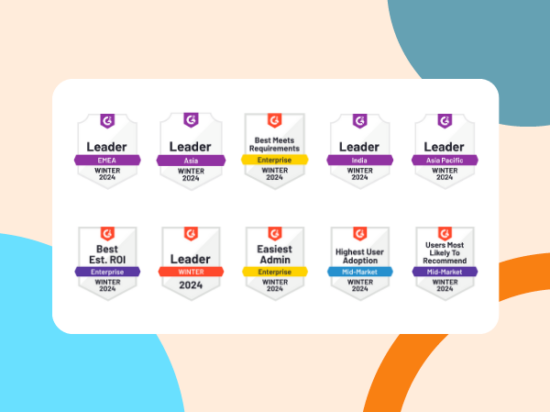The demand for a flexible and convenient learning solution is on the rise as learners are increasingly adapting to new technologies. According to a recent report, mobile learning is a significant trend in eLearning as it improves productivity by 43%. It enables learners to acquire knowledge more efficiently and enhances their ability to implement it effectively. The productivity boost is attributed to the flexibility and accessibility offered by mobile learning, allowing learners to engage with educational content at their own pace and convenience.
The same report also states that leaders from different sectors experienced a 55% boost in their business after implementing mobile learning as a training method for their staff. It allowed employees to conveniently access their training materials and courses while on the move.
These trends emphasise the recognition of mobile learning as a dynamic tool capable of improving individual performance and supporting organisational profitability. Mobile learning empowers individuals to acquire knowledge anywhere and at any time. Many apps have offline capabilities, which makes continuous learning even more appealing.
In this article, we will delve into the strategic implementation of a mobile learning approach using the Moodle App, exploring its features and benefits in fostering a dynamic and effective learning environment.
The benefits of the Moodle App
The Moodle App is designed for inclusive and accessible learning, addressing the challenges of learners with limited internet connectivity or desktop access. At Moodle, the commitment to continuous learning is always encouraged, and we also recognise that connectivity issues shouldn’t be a constraint in educational opportunities. By using the Moodle App, learners can easily access the Moodle platform, whether online or offline, from any location and device.
For instance, Mwabu – a company aiding African primary school teachers with technology for better learning outcomes – customised the Moodle App to overcome challenges like the lack of resources, internet accessibility, and the hardware to access courses offline. They used it to deliver African-centric digital content, provide cost-effective hardware, conduct teacher training, and implement advanced online/offline data capture and analytics. Even in remote areas, students received tablets with a preloaded app that syncs with Mwabu’s custom Moodle platform. Early stats show a remarkable 10% improvement in math scores and an impressive 12.4% boost in oral vocabulary skills. Mwabu’s success showcases how the Moodle App breaks educational barriers, ensuring accessibility and driving tangible academic advancements.
Implementing the Moodle App for the best learning experience
Mobile learning has become more convenient and accessible through applications like the Moodle App. It allows learners to study on the go and even offline, freeing them from the confines of traditional educational settings. However, to ensure that mobile learning is effective, it is important that the apps used for it are user-friendly and easy to navigate. The accessibility of education for all learners becomes challenging if complexity is not regulated.
To maintain a user-friendly approach to mobile learning, a sustainable strategy that is learner-centric is essential. The goal should be to simplify and establish an environment where learning is engaging and practical.
Tips to apply mobile learning strategy
To help you make the most of mobile learning, here are some strategies that you can use.
Understand the learner
If you are an educator or a trainer, then it is important to take the time to understand your learners. Explore their unique needs, preferences, and technological comfort levels. It is recommended that you also consider factors such as the devices they commonly use, any connectivity constraints that they might face, and their learning preferences. You can then tailor your mobile learning strategy to these factors, ensuring that your learners receive a personalised and effective educational experience.
Create mobile-friendly content
As more and more learners are accessing their courses through mobile devices, it is important that all courses are optimised for mobile use. Applications such as Moodle App make the process easier by allowing educators and trainers to enable mobile access on their Moodle sites. Educators and trainers can use responsive HTML to ensure that the content adapts to different devices while maintaining a visually appealing presentation. Options like Page or Book provide an ideal alternative to downloadable materials and help deliver information in a concise and learner-friendly manner. You can also add YouTube videos, but it is recommended that they are short, not more than 5 minutes, in order to enhance user engagement. It’s important to ensure that the videos can be downloaded for offline viewing by placing them in downloadable folders, preferably in MP4 format. If you want to make sure that your videos or slideshows are displayed properly on all screens, you can use Bootstrap’s responsive classes to create responsive embeds. If you have larger audio files, it’s best to place them directly on the page to ensure continuous playback, even if the device screen turns off. These strategies empower educators and trainers to craft dynamic, accessible, and interactive content that enhances the overall learning experience on the Moodle App.
Embrace microlearning
Implementing microlearning as a mobile learning strategy proves to be highly effective, aligning with the natural way users consume content on mobile devices. Microlearning involves breaking down learning into small, focused units, a method known to enhance retention and foster a sense of accomplishment. Mobile devices are an ideal platform for delivering short and meaningful bursts of learning, given the prevalence of bite-sized content consumption. With the help of Moodle LMS, educators can create a diverse range of engaging and accessible activities, incorporating text, images, videos, and audio, which can be accessed by learners on the Moodle App. This adaptability caters to various learning preferences, ensuring quick comprehension and reinforcing the effectiveness of microlearning within the mobile learning landscape.
Conclusion
In conclusion, embracing a mobile learning strategy with the Moodle App holds immense potential for transforming the educational landscape. The flexibility and accessibility offered by mobile learning address the diverse needs of learners, while the Moodle App provides a strong platform for creating engaging and adaptive content. From responsive HTML and microlearning to accommodating various multimedia formats, the app facilitates a dynamic and personalised learning experience. Its features enable educators and trainers to tailor content to different learning preferences and ensure offline access, making education available anytime, anywhere.
Optimise your Moodle App experience! Join our intermediate-level administrator course to master Moodle site configuration and create mobile-friendly courses.


